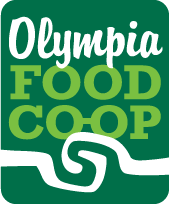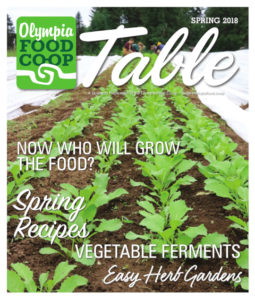Co-op Table Spring 2018 PDF
THE EASIEST GARDEN IS AN HERB GARDEN
If you have any kind of outdoor space available to you – a yard, a porch, or windowsill you can hang a planter box from – I advise you to plant an herb garden. So long as you choose the right plants, an herb garden can be ridiculously easy to start and care for. Unlike vegetables, most of the plants we call herbs are undomesticated, wild plants that haven’t been bred to rely on human care. Given the right conditions they can get on just fine all by themselves, needing little to no water, fertilizer, pest control or weeding once they are established. On top of that, many of the herbs I love best are perennials or self seeding annuals that will come back year after year with no work on your part. Be forewarned, however, if you are most comfortable with a tidy and predictable garden, some of these plants may not be for you!
While the upkeep is easy, getting herbs started has varying levels of difficulty – some of these wild plants have evolved to spread like weeds, easily sprouting from seed scattered on the ground, while others have evolved to sprout from seed only under very specific conditions. Trying to get these fussy plants to sprout (rubbing them on sandpaper or hiding them in the fridge, among other tricks) can be a fun way to feel like a mad scientist. For the sake of my argument that your herb garden can be extraordinarily easy, I’m going to recommend that for fussy seeds and woody perennials, you just spend a few bucks on potted starts. We are lucky at the Co-op to be able to get an incredible variety of herb starts grown locally and sustainably at Spring Creek Farm, a family run business in Rochester. For those plants that do grow easily from seed (and the persnickety ones you want to experiment with!), we are really excited to offer organic herb seed from Oregon based seed company Strictly Medicinal, run by herb growing pioneer and mad scientist Richo Cech.
I don’t just think you should grow an herb garden because it’s easy. Herbs are also exceptionally useful and will bring you joy. Having fresh herbs on hand to cook with is more fun and more delicious! Making tea with the plants in your garden is pure happiness. Traditionally, herbs have been eaten in food, steeped in tea, and transformed into other concoctions to treat countless maladies and promote general well being. Experimenting with herbal medicine can be a really empowering and exciting experience. Below are some top picks for herbs to cultivate and easy tips on how to start and care for them.
FAVORITE CULINARY HERBS
These can all be used fresh or dried in just about any combination. You will find them in all kinds of recipes, and have fun experimenting with adding them to whatever foods you like to eat.
Parsley (Petroselinum crispum)
Parsley plants are low, bushy herbaceous biennials (plants that live 2 years). We have starts for Italian and curly varieties. Seeds are available, but you’ll want to start them indoors and give seeds a long soak prior to planting. Parsley likes full sun and regular garden soil.
Dill (Anthmum graveolens)
Dill is an annual that is almost too easy to grow. Sow seeds directly into a patch of regular garden soil with full sun in early spring. They grow tall with beautiful yellow flowers loved by bees and humans.
Sage (Salvia officinalis)
Sage is a mid-sized woody shrub. It can take a long time for woody plants to establish grown from seed and sage will need frequent weeding until it gets woody, so I recommend getting a start if you want to keep it easy. Spring Creek grows a bunch of different varieties! Sage wants full sun and well-drained soil. Water sitting on its leaves may mildew, so avoid planting it where it will get pounded with water and won’t have enough airflow to dry.
Thyme (Thymus vulgaris)
Thyme is a very small shrub with cute little flowers that attract bees. It has a strong preference for sun and dry, gritty, alkaline soils. If you live west of the Cascades your soil is probably fairly acidic, and you want to keep it slightly acid if you grow vegetables, so your thyme will probably do best in a planter where you can control the soil conditions a bit better. Like sage, it’s much easier to buy a start than to grow from seed. I almost didn’t include thyme on this list since it can be a bit fussy, but it’s my absolute favorite culinary herb so I had to mention it.
Rosemary (Rosmarinus officinalis)
Soil drainage is essential for rosemary to be happy. Richo Cech recommends a mulch of sand around the base to reflect light up to the leaves, keep weeds at bay, and help with drainage. It is almost never grown from seed, but we have starts for so many different varieties. They have gorgeous blue flowers and can grow quite big: 3’-4’ high and just as wide.
Chives (Allium shoenoprasum)
Tiny clumping onions are fairly easy from both start or seed provided you follow the instruction on the seed packet. It likes regular garden soil and can take part shade. It will be happier in moist soils. In my mind this is the most classic garden herb; I’ve seen it growing in just about every garden I’ve ever seen, probably because it’s so easy to care for and goes well in every dish.
HERBS FOR DELICIOUS TEA
Use leaves and flowers, fresh or dried, (cut the above ground part of the plant, gather them into small bundles, and hang upside down in a dry, dim place) to make tea just by adding boiled water and allowing to steep 10 minutes with a cover on (so the aromas don’t escape). Any combination of these herbs will make a delicious tea that I have found settles the stomach and the mind.
Lavender (Lavendula spp.)
Lavender is a beautiful and wellloved shrub. Spring Creek grows many different species and varieties of lavender; Grosso is one of the most fragrant. Lavender needs well drained soil and full sun. Richo recommends sand mulch for these too. If you want to grow from seed, they will need a couple weeks of cold conditioning. Lavender can grow 2’ – 4’ tall depending on the type; take note of how large they will get when planting to ensure enough space between plants.
Lemon Balm (Melissa officinalis)
A citrus-smelling herbaceous perennial which will multiply rapidly with no help from you and produce abundant leaves twice a year. Some people don’t like how much it spreads, so if you want a very tidy garden it might not be the plant for you. Lemon balm tolerates poor soils, drought, and part shade so if you’ve got an abandoned corner where nothing else will grow this could be a perfect herb for you. A little tricky from seed, pick up a start instead or see if a neighbor will let you dig up some of theirs.
Mint (Mentha spp.)
All types of mint are tenacious and prolific reproducers. Like lemon balm, it may not be for lovers of an orderly garden, but if you put it in a pot it will probably stay put. Some mints reproduce by underground stems (rhizomes) rather than by seed, and it spreads so well that I think getting a start is a worthwhile investment, but we have seeds for a few varieties. Spring Creek has starts for many varieties of mint. My favorite are chocolate mint and spearmint.
Chamomile, German (Matricaria recutita), Roman (Chamaemelum nobile)
German chamomile is a self-seeding annual, whereas Roman chamomile is a perennial ground-cover. They both look like cute little daisies and smell sweet. Both can be direct seeded outdoors in early spring, fall, or midwinter. They do pretty well from seed but can be transplanted as well. They like regular, moist garden soil.
Anise Hyssop (Agastache foeniculum)
Anise hyssop is a delicious and lovely herbaceous perennial. Starts will grow fairly tall and have a tendency to spread, but much less aggressively than lemon balm. Thrives in full sun and regular garden soil.
MEDICINAL HERBS
If you have an interest in herbalism, there are quite a few plants traditionally used for medicine that you can find at the garden center. Some medicinals are extremely difficult to cultivate, but these are all ones that I have found incredibly easy to grow.
Skullcap (Scutellaria lateriflora)
An herbaceous perennial that will spread like wildfire by rhizome and seed, making it a bad choice for those who fear plants who leave their intended spot, but great if this is an herb you love and use lots of. It can be direct seeded fall or spring, but I’ve just been dividing the same start I got for a couple of years now. They prefer moist, fertile soil and take part or full sun.
Feverfew (Tanacetum parthenium)
Daisy like herbaceous perennial with lacy foliage. It easily establishes from both start and seed – maybe too easily for some people’s taste as it can get a bit weedy. Loves full sun and well drained soils.
Mugwort (Artemisia vulgaris, A. ludoviciana)
Both the European and American varieties grow abundantly once established. They are pretty tricky to start from seed, but a start can be divided and it will spread pretty quickly. Likes full sun and dry soil.
Motherwort (Leonurus cardiaca)
One small start will grow into a big, wily plant that provides more than enough for my needs. It can also be direct seeded in spring or fall. It takes partial to full sun in regular garden soil and likes to be watered daily in the hot months.
Calendula (Calendula officinalis)
Calendula seeds can be scattered willy nilly across the soil and will produce an abundance of beautiful orange and yellow flowers. These in turn, will produce a mother load of seeds which will fall to the earth and sprout the next year (or even later in that same year) giving you even more calendula with no effort on your part. They prefer full to part sun and don’t seem very picky about soil.
Yarrow (Achillea millefolium)
Yarrow can be direct seeded into any soil and will produce prolifically with little water. It does prefer full sun. Its leaves and flowers are beautiful and highly aromatic.
California Poppy (Escholzia californica)
Grows easily from seed. Direct sow into cold soil in winter or early spring and it will
Self sow in even the most infertile soils. Both flower and foliage are adorable.
By Sylvan Rook, staff member

